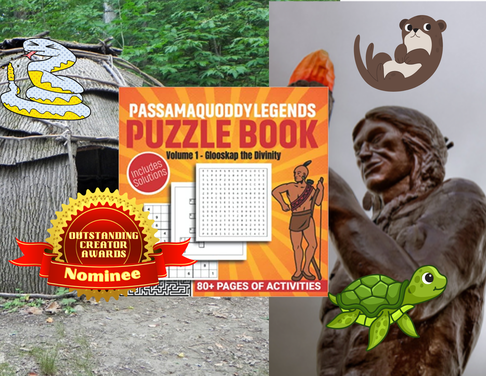|
Score: 94/100 (9.4 out of 10)
This puzzle book is the perfect companion piece to “Passamaquoddy Legends” as it helps readers of all ages to review the fascinating and intricate details of these incredible Native American legends. It's a welcomed treat since these legends were very fun to read, but the problem remained that they were sometimes challenging to read because of the unique Passamaquoddy terminology used throughout. This workbook seeks to rectify that by making learning these new terms and complex stories via fun puzzles of various kinds. You can tell that author Michael Cook deeply cares about the material and the subject matter. He could have simply made a few coloring pages or a few puzzles, but he went all out. There are dozens upon dozens of different puzzles to go through, and all of them are interesting in their own ways. For one, pretty much all of them cover one of these fascinating legends or an aspect of them. They do this in a way that helps the reader learn and remember what they read. Reviewing and learning actively are always useful tools in acquiring new information. For example, in the course of doing these puzzles, we realized that even stories we thought we were the most familiar with, like “Glooskap is Making Arrows,” Glooskap is not alone in making these arrows for the Great Battle ahead. Sogma is also involved in making arrows, and they do this constantly. Also, words that we kept seeing but that we didn't know the meaning to are clarified, like wigwam (a dwelling or home). We were also impressed by how much we'd learned and remembered from the parent text. For example, we knew what “Wabanaki” was (the Children of Light) and also “Iglesmani” (the white man). There are also some fun and cool, albeit slightly advanced, connect-the-dot games. Your child could presumably do this with perhaps some supervision, but like most of these, they're mainly for adults or young adults. These create amazing figures like snakes, bears, and turtles. A lot of thought and effort clearly went into this. Is it still a lot to learn and sometimes a bit overly difficult? Maybe. For example, some of the answers are actually very specific, and you'd have to really do a “CTRL + F” search of the parent text to find the correct answer (unless you're just going to guess or try to cheap by looking at the back of the book). Where's the fun in cheating? But even guessing can be difficult if you don't have the Passamaquoddy terminology down. It's still a foreign language to most of us. Maybe we're just not Sudoku kind of people, but the number block sections were parts we just decided to skip over after a few tries. They just got a bit much. That's not to say that you can't find some joy in solving them though. Things like crosswords and word searches, now, anyone can do, and we definitely enjoyed the process. So, in conclusion, we're giving this book our highest rating yet for a workbook, albeit this is one of the few we've judged, and the others were in entirely different genres. This “Passamaquoddy Collection”--as you will—holds a very unique and special place in our hearts. There's just nothing like it. We read a collection of poems about the Aboriginal people of Australia, but that was a collection of poems aimed at activism, not a collection of legends aimed at entertaining while educating. So, we're giving it a 9.4—an exceptionally good score shared by books near the very top of children's books and eloquently-written fiction books. It also shares the same score as the parent text. That seems like a fair score. Michael Cook clearly cares about all this. Apparently, he grew up next to a Passamaquoddy reservation in Maine, becoming personally acquainted with their people and culture. He is pursuing his doctorate at Liberty University, and we're confident he'll get it with his work ethic and intellect. Check out this book and its parent text on Amazon!
0 Comments
Leave a Reply. |
Archives
July 2024
Categories |

 RSS Feed
RSS Feed